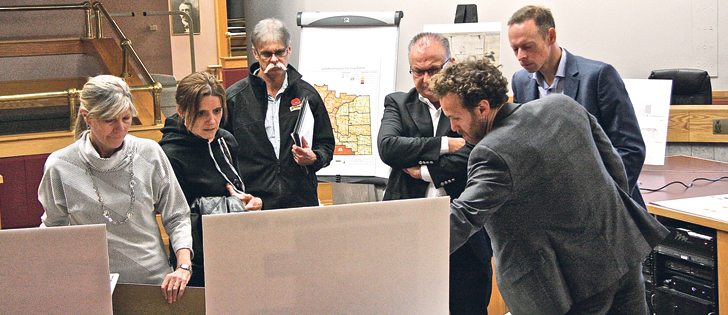MOOSE JAW, Sask. — Diane Monk might have to build a fence to keep her Great Pyrenees dog from chasing trucks, but she says having Canadian Protein Innovation for a neighbour will be just fine.
Monk lives on 22 acres on the same quarter where the company hopes to build a pea fractionation plant. It would process 100,000 tonnes of yellow peas annually into starch, protein and fibre, mainly for the North American market.
At an open house held in Moose Jaw city council chambers Nov. 9, Monk learned there would be 2,500 trucks per year, about 12 per day, delivering peas, as well as other trucks leaving with packaged material.
Read Also

Farming Smarter receives financial boost from Alberta government for potato research
Farming Smarter near Lethbridge got a boost to its research equipment, thanks to the Alberta government’s increase in funding for research associations.
“It sounds like it’s going to be busy,” she said.
She isn’t worried about dust because the road is to be upgraded, although not necessarily paved.
There will be buffer zones of either 20 or 30 metres between her and the facility, and she isn’t likely to smell any potential odour because the plant will be east of her home; the prevailing winds in the region are northwest.
“Personally, I have no problem with this,” she said.
“It’s great for Moose Jaw. It’s great for Saskatchewan. With the economy the way it is, anything they bring in is going to be a benefit.”
Others were concerned about the smell from the city lagoons, which will hold the plant’s waste water.
One woman told CPI officials that rumours are circulating throughout the region that the smell will be nasty. She said she was worried property values would decline.
CPI director Uli Duka said residents who don’t smell the existing lagoons shouldn’t worry.
Director Michael Schonert noted a similar plant, which uses potatoes, is right in the heart of the German community where he lives.
The company’s plan calls for the waste water to be pumped to the lagoons and then disseminated through 21 effluent irrigation pivots already used by local farmers.
Schonert said that just makes sense.
It’s possible the waste water could smell during summer heat, but that is when the farmers will be using it, he said. It will be cold when the waste water has to be stored, so there should be no smell.
He also said the proposal falls under regulated limits for noise, dust and odour.
Two open houses were held last week because a pea plant is not on the list of approved uses for the city-owned land located in the Rural Municipality of Moose Jaw.
The location was selected because the city has enough services to supply and maintain the facility, as well as a labour source that the company will train.
The $75 million plant will be built largely with local workers and employ 65 people initially; it is designed to double capacity. Processing will occur Monday through Friday in one or two shifts.
All the yellow pea supply will come from Saskatchewan growers. Schonert said they must be clean and free of any gluten-containing contaminants such as cereals.
Zafer Bashi, a provincial agri-business specialist, said quality isn’t a huge concern when fractionating.
“A plant like this for a year like this, especially when you have moisture during harvest, and then quality is an issue, that’s a really good place to market those peas,” he said.
“We definitely are looking at the waste water as being part of the irrigation strategy and seeing if we can incorporate it as well into the existing infrastructure, and it’s aligned quite nicely with our value-added strategy.”
The starch, protein and fibre components will go into a variety of products, including pasta, noodles, snacks, candy, vegetable coatings, animal protein replacements and industrial uses such as diesel particle filters and paper coating. Hulls will go into pet products.
Duka said statistics and market research indicate a burgeoning market for pea protein to replace animal protein in food such as “chicken” nuggets.
Products will be shipped by truck to the Global Transportation Hub at Regina and then loaded for Vancouver or the United States.
“The marketing work is done so we have a big customer, of course, in the United States that I would say is half our sales,” said Schonert.
“The other half we split a big part to Asia, but also we can reach, via Vancouver, Australia, New Zealand and some other countries.”
Duka and Schonert represent an investor, whom they identified as a German third-generation, family-owned agri-business.
“Basically (he is) a farmer with some trading activities and logistics activities, some dairy activities and of course this processing plant in the future,” said Duka
Moose Jaw’s new mayor, Fraser Tolmie, said he is happy about the possibility of developing a skilled labour force in the city.
“It’s a great opportunity for our city,” he said. “It means a growing Moose Jaw.”


















